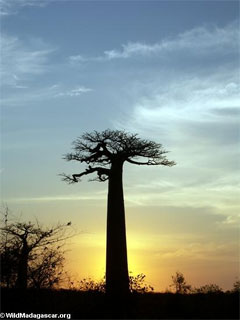Madagascar adds 15 protected areas
Madagascar adds 15 protected areas
mongabay.com
April 30, 2007
Madagascar has added 15 new protected areas covering nearly 1 million hectares (2.4 million acres) of land, reports Conservation International (CI). The move will help protect the island’s unique wildlife from extinction.
 |
The newly protected areas include “1.2 million acres of dense forest in the southeast, 684,000 acres of forests and lakes in a wetland complex on the northwest coast, and mangroves and lakes in the Menabe Central Forest,” said CI in a statement.
“Anyone who says conservation and development cannot work hand-in-hand is wrong,” says Madagascar President Marc Ravalomanana. “It is important to stress the positive impact biodiversity conservation has on economic development and quality of life.”
Ravalomanana has moved to protect some 2 million hectares of land over the past two years. He aims to protect 10 percent of the California-sized island by 2008.
Famous for its lemurs, Madagascar is one of the most biodiverse countries on Earth. The island’s high number of endemic species have made it a top global conservation priority.
Related articles
Lemur conservation in Madagascar requires poverty alleviation initiatives. Madagascar, an island larger than France that lies off the southeastern coast of Africa, is perhaps best known for its lemurs–primates that look something like a cat crossed with a squirrel and a dog. Lemurs, which are found naturally only in Madagascar, serve as a charismatic representation of the island’s biodiversity and its problems. Since the arrival of humans some 2000 years ago from southeast Asia, Madagascar has lost all of its mega fauna and more than 90 percent of its wildlands. Today forest clearing for agriculture and hunting continues to put lemurs and other endemic species at risk. The good news is that because of Madagascar’s biodiversity, the island has become a top priority for global conservation. At the forefront of these efforts is the Madagascar Fauna Group (MFG), an international consortium of zoos and related organizations that work to protect Madagascar’s wildlife and ecosystems, and the Duke University Lemur Center, the one of the world’s leading lemur research facilities. Charlie Welch, currently a research scientist at the Duke University Lemur Center, recently answered some questions on his experiences in lemur conservation. Welch, along with his wife Andrea Katz, has worked in Madagascar for 17 years and helped transform conservation efforts in the country.
Lemur land, Madagascar now protected. Madagascar is one of the world’s most special places. An island slightly larger than the state of California, Madagascar is home to a bewildering array of wildlife from dancing lemurs to absurdly colorful chameleons. Eighty percent of the island’s species are endemic, meaning they are found nowhere else on Earth.
Dancing lemur attracts tourists to island of Madagascar. In the dry deciduous forests of south western Madagascar there lives a lemur that loudly cusses but “dances” like a ballet performer. Verreaux’s sifaka is among the most popular of lemur species, a group of primates endemic to islands off the southeastern coast of Africa. While threatened, Verreaux’s sifaka is easily spotted is several of Madagascar’s more accessible parks.